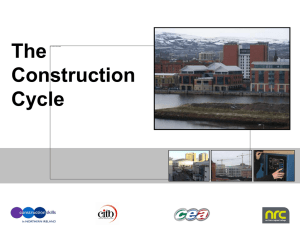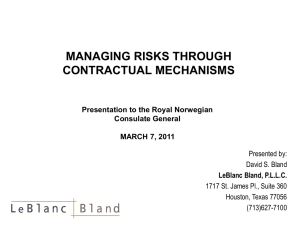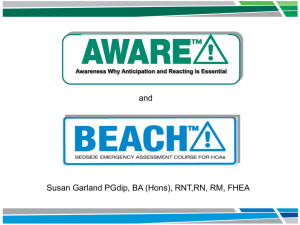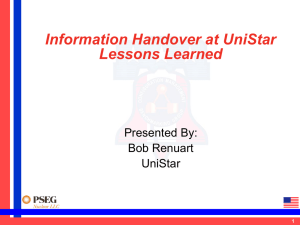Presentation - The Warren Centre for Advanced
advertisement
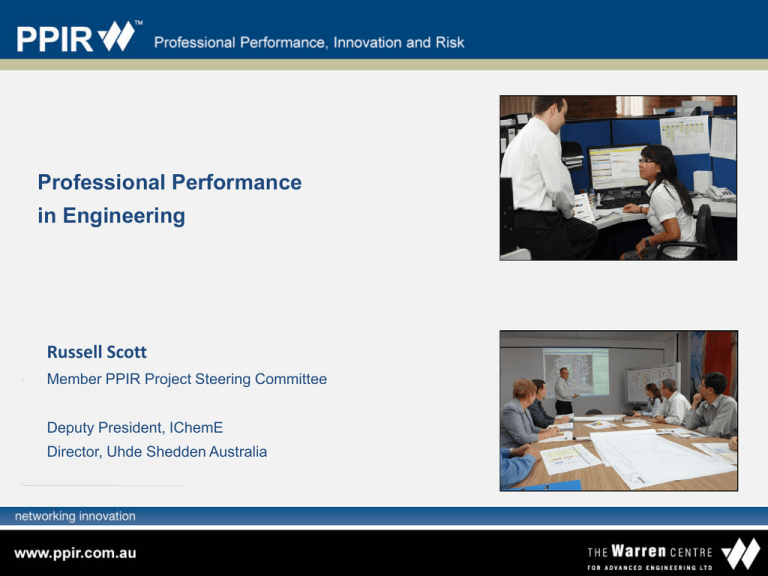
Professional Performance in Engineering Russell Scott Member PPIR Project Steering Committee Deputy President, IChemE Director, Uhde Shedden Australia Who is Uhde Shedden? Uhde Shedden Multidiscipline Engineering Contractor Serving the process industries From concept development to project delivery Employing ~ 300 staff in Melbourne and Brisbane Part of a major global contracting company Key Targets Create high-performing teams Achieve excellent project outcomes Achieve high customer satisfaction Drive accountability for performance to the individual level Why Does the Industry Need PPIR? “Everyone did his job perfectly but the project was a failure” “We knew it was going to be a disaster from the start” “It doesn’t make sense but that lawyers made us do it that way” “Don’t blame me, the client told me to make the change” “It’s not my fault we’re running late; you’ll just have to wait” Performance : “How does the professional engineer approach, arrange and undertake a new task The eight elements of to ensure delivery of the The PPIR Performance Protocol final agreed outcome” Plain language summary as used within Uhde Shedden PPIR Element Plain Language Summary Relevant Parties and Other Stakeholders Do you clearly understand the relationship with the people who depend on you, and those you depend on, and their expectations? The Engineering Task Have you discussed and agreed with the person you are working for the objectives and extent of the task you are doing? Competence to Act Have you checked that you have the skills, tools and resources required to do the job? Statutory Requirements and Public Interest Have you identified and responded to relevant statutory requirements and public interest issues? Risk Assessment and Management Are you effectively identifying and managing risks which may prevent the proper performance of the job? Engineering Innovation Are you considering innovative ways of doing your job better? Engineering Task Management Are you applying the appropriate task management processes? Contractual Framework Are you considering implications of the contract under which the work is being done? Summary of typical issues in complex project delivery Project Handover Poor handover of scope and contractual basis from Sales to Project Manager Tight Budget influenced by client’s need to get project sanction Design Basis not clear from the start Contract Variation claims poorly managed Scope Changes through project; not fully assessed Impact on Schedule Communication of scope changes not fully considered Client dealing directly with Contractors; Project Manager not informed How the PPIR Protocol addresses issues in project delivery Project Handover Relevant Parties and Other Poor handover of scope and contractual basis from Stakeholders Sales to Project Manager Tight Budget influenced by client’s need to get project sanction Design Basis not clear from the start Contract Variation claims poorly managed The Engineering Task Contractual Framework Scope Changes through project; not fully assessed Communication Impact on Schedule Engineering Task Management of scope changes not fully considered Risk Assessment and Management Client dealing directly with Contractors; Project Manager not informed Adoption of PPIR – Success Factors • Identification of benefits to the Company and its employees • Commitment of senior management • Regular communication to the total organisation • Integration into company procedures • Training for supervisors and other staff • Launch – with visible management support • Embedding into Company behaviour Introduction of PPIR to the Company Key Stakeholder Briefing Supervisor Training Session Briefing Company Intranet Publicity Senior Management How Uhde Shedden Introduced PPIR within its organisation Incorporating PPIR in the Business Processes Embedding Professional Performance in the Company Position Description / Performance Assessment Incorporation into Procedures Training


